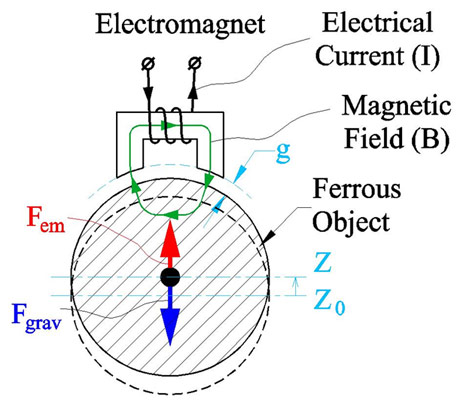How Magnetic Bearings Work
Calnetix has created a detailed white paper explaining how magnetic bearings work.
To download a copy, click here.
Excerpt from Calnetix’s white paper entitled, “General Explanation of How Magnetic Bearings Work”
Magnetic Bearings are devices used to support (levitate) objects using magnetic forces. Some magnetic bearings provide a full non-contact support of an object, whereas others provide only a partial support working together with more conventional mechanical bearings.
While a wide variety of magnetic bearings have been developed, only one type has been widely accepted in the industry so far - Active Magnetic Bearings (AMBs). This is because an active magnetic bearing can exert higher-density forces on surfaces of supported objects than any other type of magnetic bearing. They can also operate in a wide range of environments and their properties can be made highly configurable through software parameters. Ongoing dramatic improvements in Digital Signal Processors (DSP) – faster performance, integration of important peripheral features and cost reductions have further boosted commercial attractiveness of active magnetic bearings.
The basic operating principle of an active magnetic bearing is very simple. A ferrous object is known to be attracted to a permanent magnet or an electromagnet (an electrical coil wound around a ferrous core). For example, Figure 1 shows a ferrous object which will be attracted to an electromagnet located next to it whenever the coil is energized with a current. Note, that the force between an electromagnet and a ferrous object is always attractive – it cannot be repulsive.

FIG.1
The pulling force exerted by the electromagnet on the object depends on two parameters:
a.) Current I in the electromagnet, and
b.) Distance or gap g between the object and the electromagnet.
If the current I does not change, the force Fem pulling the object towards the electromagnet will get stronger when the rotor gets closer to the electromagnet. Because of this, and the gravity force Fgrav effectively does not change with the rotor position, if you bring the rotor close enough to the electromagnet for the electromagnetic force Fem to overcome the gravity force Fgrav, the rotor will jump to the electromagnet and stick to it. Alternatively, if you place the rotor too far from the electromagnet where the gravity force is larger than electromagnetic force, the rotor will fall on the floor.
This behavior is just opposite to what would happen if the rotor was suspended on a spring as shown in Fig. 2 - the force with which spring would pull the rotor up would get weaker when the rotor moves up and stronger when the rotor moves down. It is said that a spring suspension shown in Fig. 2 has a positive stiffness (defined as a rate at which spring force changes with the rotor displacement taken with a negative sign) whereas the electromagnet suspension shown in Fig. 1 has a negative stiffness. We know that an object can be suspended on a spring as shown in Fig. 1, but it is not possible to suspend an object using an electromagnet shown in Fig. 1 without it coming to a full contact with the electromagnet.
FIG. 2
Click the links to learn more about additional topics:
Position Control in a Magnetic Bearing
Bias Current (or Flux) Linearization
PM Bias, Homopolar Magnetic Bearings